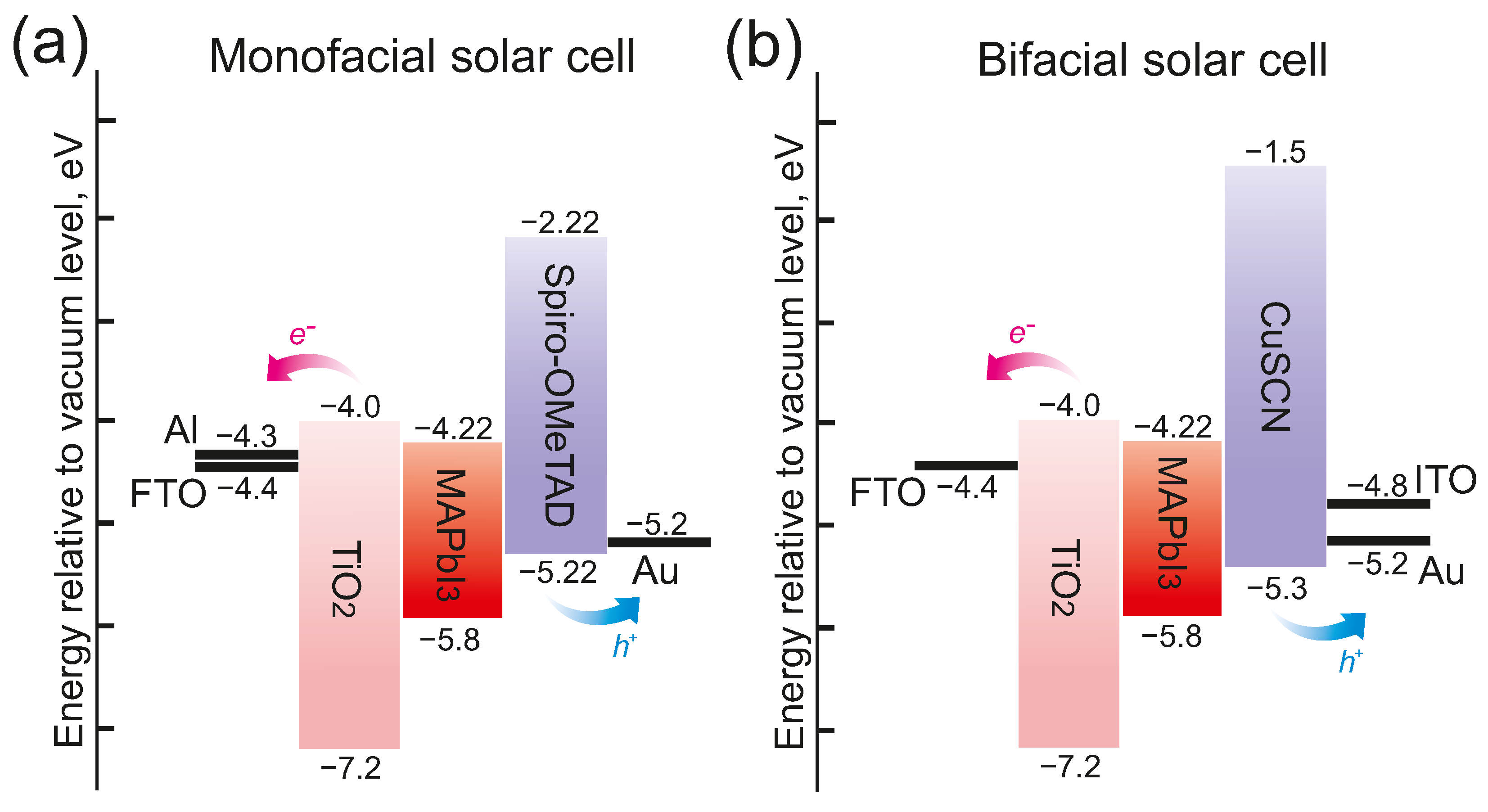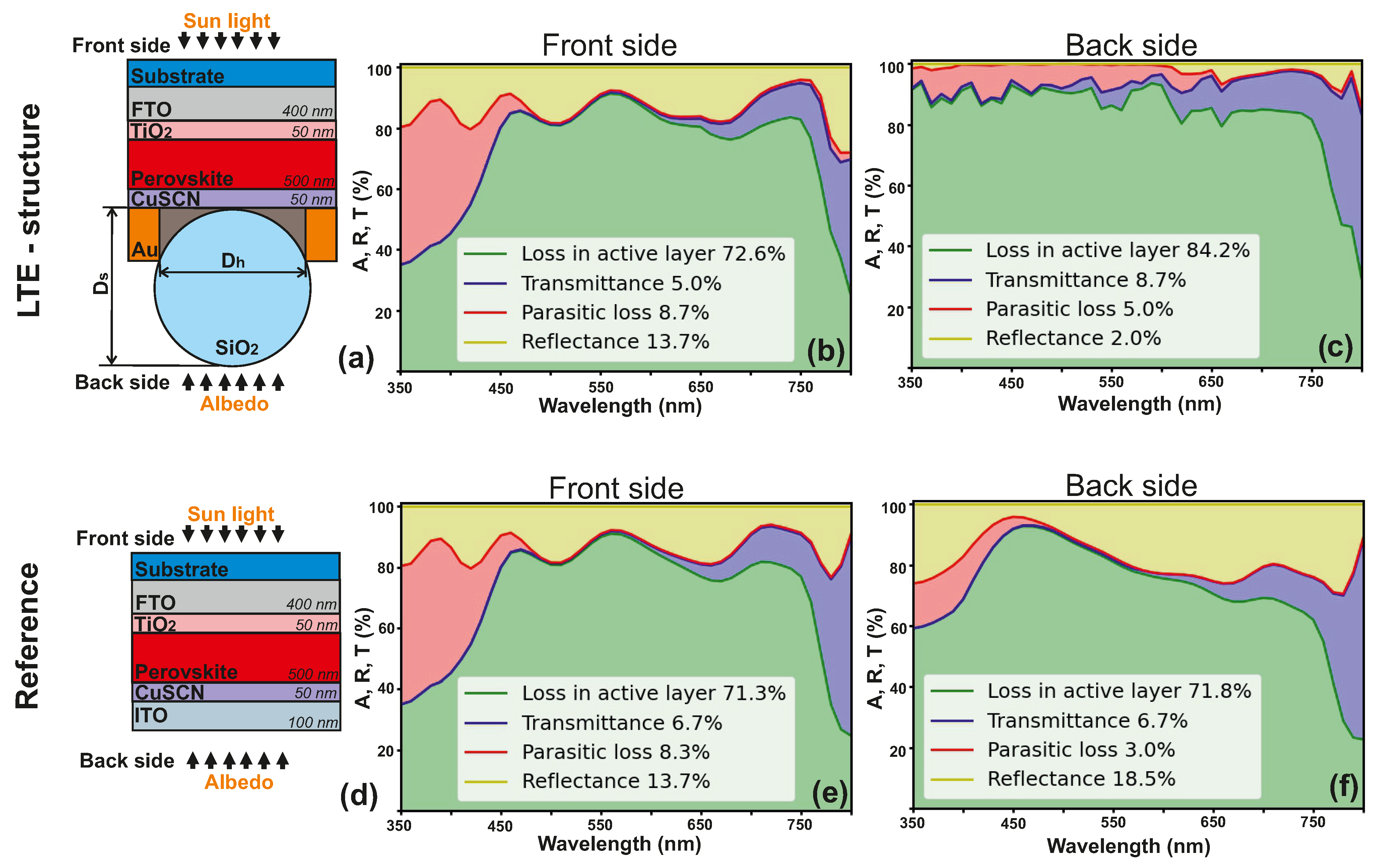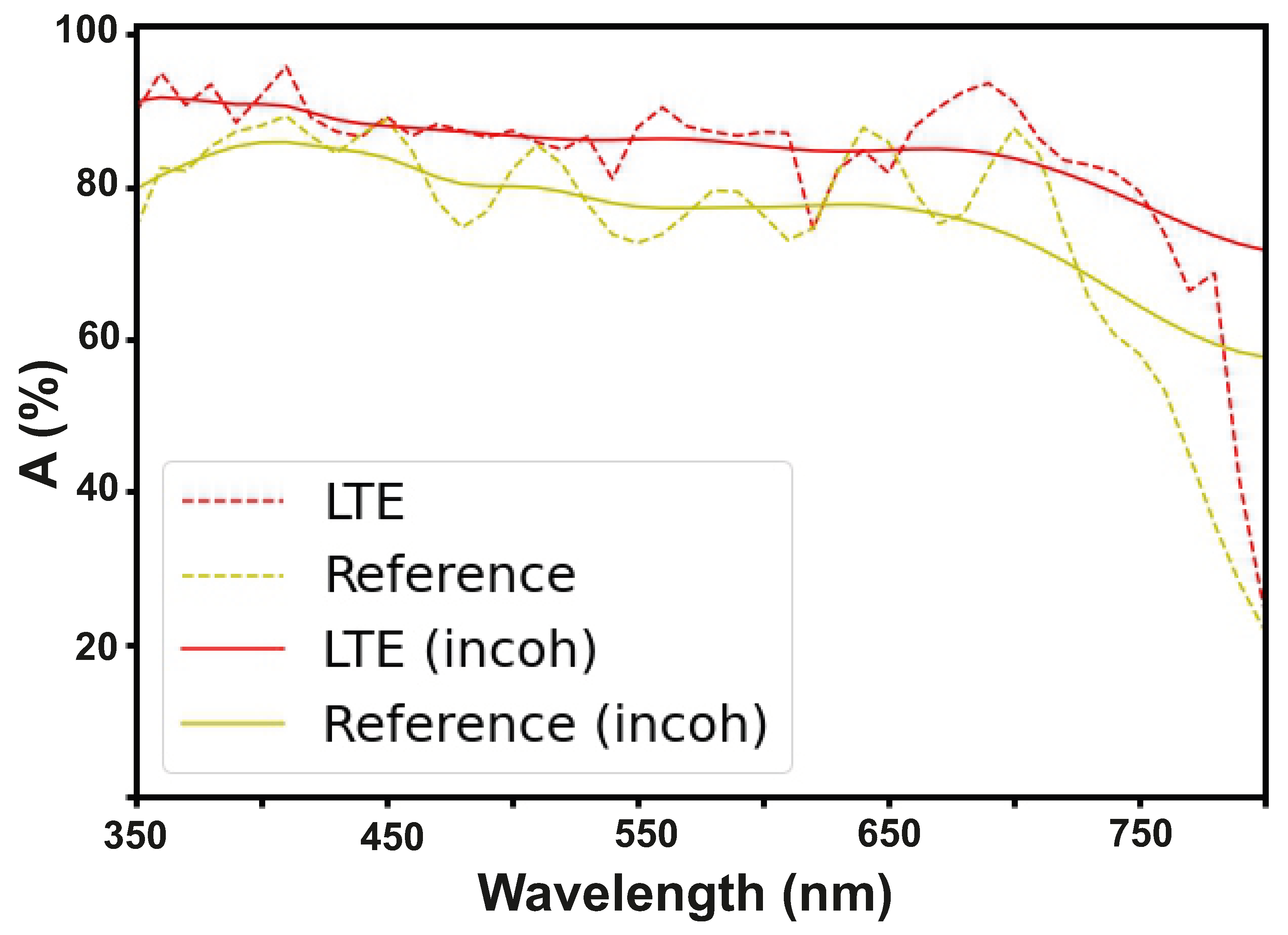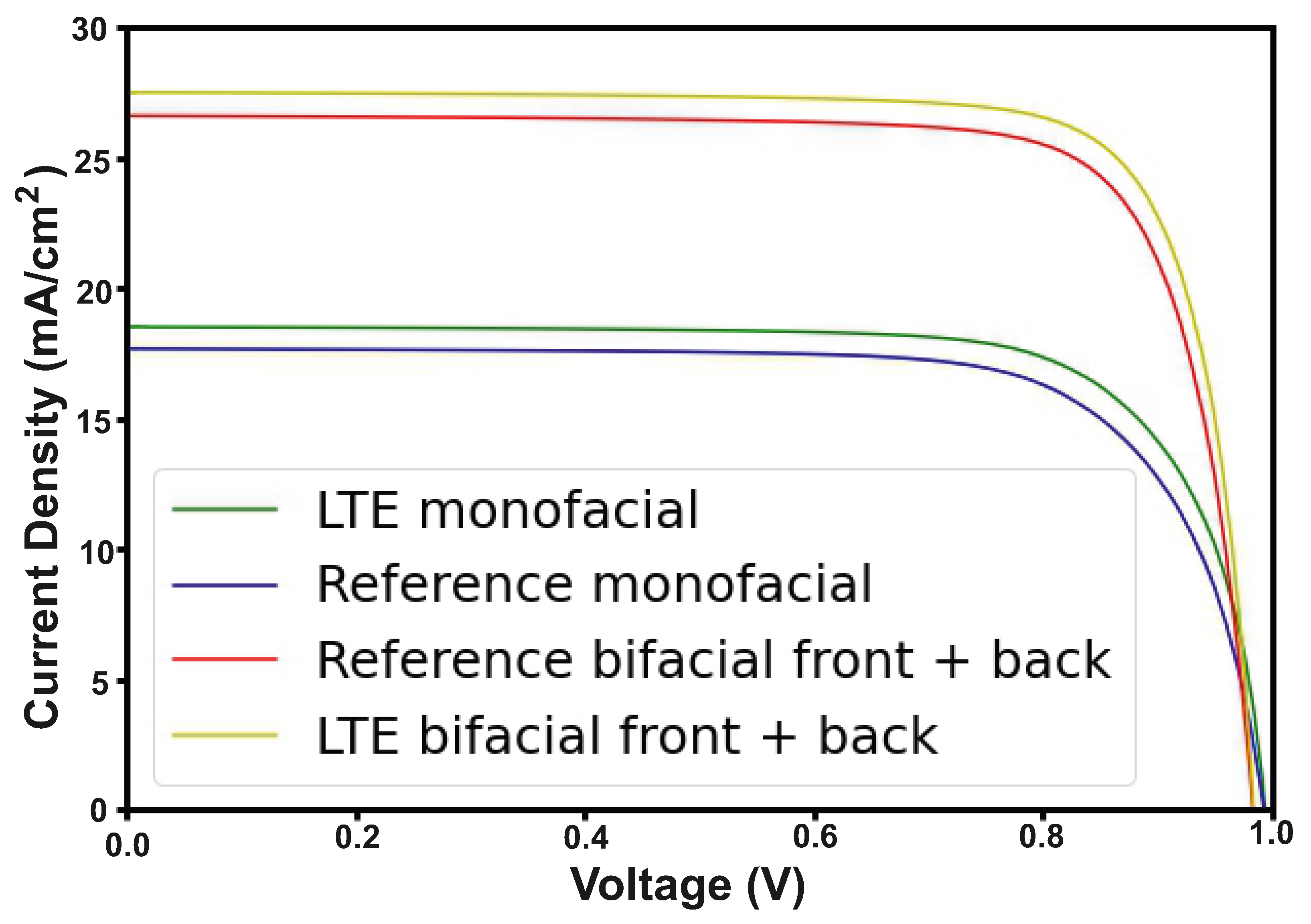Light-Trapping Electrode for the Efficiency Enhancement of Bifacial Perovskite Solar Cells
Abstract
1. Introduction
2. Design and Methods
2.1. The Proposed LTE-Structure
2.2. Optical Properties of Nanospheres
2.3. Optical Calculations
2.4. Electrical Calculations
3. Results
3.1. Optical Analysis of R, T, A for the Monofacial Perovskite Solar Cell
3.2. Optical Analysis of R, T, A for the Bifacial Perovskite Solar Cell for the Front and the Back Side
4. Incoherent Illumination
5. Electrical Analysis of Monofacial and Bifacial Perovskite Solar Cells
6. Conclusions
Supplementary Materials
Author Contributions
Funding
Data Availability Statement
Acknowledgments
Conflicts of Interest
Abbreviations
| PSCs | Perovskite solar cells. |
| LTE | Light-trapping electrode. |
| PCE | Power conversion efficiency. |
| TCOs | Transparent conducting oxides. |
| PV | Photovoltaic. |
| Ds | Diameter of sphere. |
| Dh | Diameter of hole. |
References
- Zhang, H.; Ji, X.; Yao, H.; Fan, Q.; Yu, B.; Li, J. Review on efficiency improvement effort of perovskite solar cell. Sol. Energy 2022, 233, 421–434. [Google Scholar] [CrossRef]
- Furasova, A.; Voroshilov, P.; Sapori, D.; Ladutenko, K.; Barettin, D.; Zakhidov, A.; Di Carlo, A.; Simovski, C.; Makarov, S. Nanophotonics for Perovskite Solar Cells. Adv. Photonics Res. 2022, 3, 2100326. [Google Scholar] [CrossRef]
- Guerrero-Lemus, R.; Vega, R.; Kim, T.; Kimm, A.; Shephard, L. Bifacial solar photovoltaics—A technology review. Renew. Sustain. Energy Rev. 2016, 60, 1533–1549. [Google Scholar] [CrossRef]
- Luque, A.; Cuevas, A.; Ruiz, J. Double-sided n+-p-n+ solar cell for bifacial concentration. Sol. Cells 1980, 2, 151–166. [Google Scholar] [CrossRef]
- Hezel, R. Novel applications of bifacial solar cells. Prog. Photovoltaics Res. Appl. 2003, 11, 549–556. [Google Scholar] [CrossRef]
- Jouttijärvi, S.; Lobaccaro, G.; Kamppinen, A.; Miettunen, K. Benefits of bifacial solar cells combined with low voltage power grids at high latitudes. Renew. Sustain. Energy Rev. 2022, 161, 112354. [Google Scholar] [CrossRef]
- Kopecek, R.; Libal, J. Towards large-scale deployment of bifacial photovoltaics. Nat. Energy 2018, 3, 443–446. [Google Scholar] [CrossRef]
- Song, Z.; Li, C.; Chen, L.; Yan, Y. Perovskite Solar Cells Go Bifacial—Mutual Benefits for Efficiency and Durability. Adv. Mater. 2022, 34, 2106805. [Google Scholar] [CrossRef]
- Peter Amalathas, A.; Alkaisi, M.M. Nanostructures for Light Trapping in Thin Film Solar Cells. Micromachines 2019, 10, 619. [Google Scholar] [CrossRef]
- Garnett, E.C.; Ehrler, B.; Polman, A.; Alarcon-Llado, E. Photonics for photovoltaics: Advances and opportunities. ACS Photonics 2020, 8, 61–70. [Google Scholar] [CrossRef]
- Chen, C.; Zheng, S.; Song, H. Photon management to reduce energy loss in perovskite solar cells. Chem. Soc. Rev. 2021, 50, 7250–7329. [Google Scholar] [CrossRef] [PubMed]
- Voroshilov, P.M.; Simovski, C.R. Affordable universal light-trapping structure for third-generation photovoltaic cells. JOSA B 2017, 34, D77–D80. [Google Scholar] [CrossRef]
- Chen, J.D.; Jin, T.Y.; Li, Y.Q.; Tang, J.X. Recent progress of light manipulation strategies in organic and perovskite solar cells. Nanoscale 2019, 11, 18517–18536. [Google Scholar] [CrossRef] [PubMed]
- The broadband and omnidirectional antireflective performance of perovskite solar cells with curved nanostructures. Sol. Energy 2021, 224, 10–17. [CrossRef]
- Hasanah, L.; Ashidiq, A.; Pawinanto, R.E.; Mulyanti, B.; Wulandari, C.; Wiendartun; Zain, A.R.M. Dimensional Optimization of TiO2 Nanodisk Photonic Crystals on Lead Iodide (MAPbI3) Perovskite Solar Cells by Using FDTD Simulations. Appl. Sci. 2022, 12, 351. [Google Scholar] [CrossRef]
- Tooghi, A.; Fathi, D.; Eskandari, M. High-performance perovskite solar cell using photonic–plasmonic nanostructure. Sci. Rep. 2020, 10, 11248. [Google Scholar] [CrossRef]
- Omrani, M.; Keshavarzi, R.; Abdi-Jalebi, M.; Gao, P. Impacts of plasmonic nanoparticles incorporation and interface energy alignment for highly efficient carbon-based perovskite solar cells. Sci. Rep. 2022, 12, 5367. [Google Scholar] [CrossRef]
- Manzoor, S.; Zhengshan, J.Y.; Ali, A.; Ali, W.; Bush, K.A.; Palmstrom, A.F.; Bent, S.F.; McGehee, M.D.; Holman, Z.C. Improved light management in planar silicon and perovskite solar cells using PDMS scattering layer. Sol. Energy Mater. Sol. Cells 2017, 173, 59–65. [Google Scholar] [CrossRef]
- Hu, Z.; Zhang, J.; Zhao, Y. Effect of textured electrodes with light-trapping on performance of polymer solar cells. J. Appl. Phys. 2012, 111, 104516. [Google Scholar] [CrossRef]
- Cho, C.; Lee, J.Y. Multi-scale and angular analysis of ray-optical light trapping schemes in thin-film solar cells: Micro lens array, V-shaped configuration, and double parabolic trapper. Opt. Express 2013, 21, A276–A284. [Google Scholar] [CrossRef]
- Chen, Y.; Elshobaki, M.; Ye, Z.; Park, J.M.; Noack, M.A.; Ho, K.M.; Chaudhary, S. Microlens array induced light absorption enhancement in polymer solar cells. Phys. Chem. Chem. Phys. 2013, 15, 4297–4302. [Google Scholar] [CrossRef]
- Peer, A.; Biswas, R. Nanophotonic organic solar cell architecture for advanced light trapping with dual photonic crystals. ACS Photonics 2014, 1, 840–847. [Google Scholar] [CrossRef]
- Peer, A.; Biswas, R.; Park, J.M.; Shinar, R.; Shinar, J. Light management in perovskite solar cells and organic LEDs with microlens arrays. Opt. Express 2017, 25, 10704–10709. [Google Scholar] [CrossRef] [PubMed]
- Tvingstedt, K.; Dal Zilio, S.; Inganäs, O.; Tormen, M. Trapping light with micro lenses in thin film organic photovoltaic cells. Opt. Express 2008, 16, 21608–21615. [Google Scholar] [CrossRef] [PubMed]
- Dal Zilio, S.; Tvingstedt, K.; Inganäs, O.; Tormen, M. Fabrication of a light trapping system for organic solar cells. Microelectron. Eng. 2009, 86, 1150–1154. [Google Scholar] [CrossRef]
- Li, Z.; Tan, H.H.; Jagadish, C.; Fu, L. III–V semiconductor single nanowire solar cells: A review. Adv. Mater. Technol. 2018, 3, 1800005. [Google Scholar] [CrossRef]
- Consonni, V.; Briscoe, J.; Kärber, E.; Li, X.; Cossuet, T. ZnO nanowires for solar cells: A comprehensive review. Nanotechnology 2019, 30, 362001. [Google Scholar] [CrossRef]
- Garnett, E.; Yang, P. Light trapping in silicon nanowire solar cells. Nano Lett. 2010, 10, 1082–1087. [Google Scholar] [CrossRef]
- Magdi, S.; El-Rifai, J.; Swillam, M.A. One step fabrication of Silicon nanocones with wide-angle enhanced light absorption. Sci. Rep. 2018, 8, 4001. [Google Scholar] [CrossRef]
- Kim, Y.J.; Lee, G.J.; Kim, S.; Min, J.W.; Jeong, S.Y.; Yoo, Y.J.; Lee, S.; Song, Y.M. Efficient light absorption by GaN truncated nanocones for high performance water splitting applications. ACS Appl. Mater. Interfaces 2018, 10, 28672–28678. [Google Scholar] [CrossRef]
- Zhang, J.; Ai, L.; Yan, X.; Wu, Y.; Wei, W.; Zhang, M.; Zhang, X. Photovoltaic performance of pin junction nanocone array solar cells with enhanced effective optical absorption. Nanoscale Res. Lett. 2018, 13, 306. [Google Scholar] [CrossRef] [PubMed]
- Lin, Y.R.; Wang, H.P.; Lin, C.A.; He, J.H. Surface profile-controlled close-packed Si nanorod arrays for self-cleaning antireflection coatings. J. Appl. Phys. 2009, 106, 114310. [Google Scholar] [CrossRef]
- Lu, Y.; Lal, A. High-efficiency ordered silicon nano-conical-frustum array solar cells by self-powered parallel electron lithography. Nano Lett. 2010, 10, 4651–4656. [Google Scholar] [CrossRef]
- Tsai, D.S.; Lin, C.A.; Lien, W.C.; Chang, H.C.; Wang, Y.L.; He, J.H. Ultra-high-responsivity broadband detection of Si metal—semiconductor—Metal schottky photodetectors improved by ZnO nanorod arrays. ACS Nano 2011, 5, 7748–7753. [Google Scholar] [CrossRef] [PubMed]
- Fan, Z.; Razavi, H.; Do, J.; Moriwaki, A.; Ergen, O.; Chueh, Y.L.; Leu, P.W.; Ho, J.C.; Takahashi, T.; Reichertz, L.A.; et al. Three-dimensional nanopillar-array photovoltaics on low-cost and flexible substrates. Nat. Mater. 2009, 8, 648–653. [Google Scholar] [CrossRef] [PubMed]
- Kapadia, R.; Fan, Z.; Takei, K.; Javey, A. Nanopillar photovoltaics: Materials, processes, and devices. Nano Energy 2012, 1, 132–144. [Google Scholar] [CrossRef]
- Lin, Q.; Hua, B.; Leung, S.; Duan, X.; Fan, Z. Efficient light absorption with integrated nanopillar/nanowell arrays for three-dimensional thin-film photovoltaic applications. ACS Nano 2013, 7, 2725–2732. [Google Scholar] [CrossRef] [PubMed]
- Han, S.E.; Chen, G. Optical absorption enhancement in silicon nanohole arrays for solar photovoltaics. Nano Lett. 2010, 10, 1012–1015. [Google Scholar] [CrossRef]
- Leung, S.F.; Yu, M.; Lin, Q.; Kwon, K.; Ching, K.L.; Gu, L.; Yu, K.; Fan, Z. Efficient photon capturing with ordered three-dimensional nanowell arrays. Nano Lett. 2012, 12, 3682–3689. [Google Scholar] [CrossRef]
- Peng, K.Q.; Wang, X.; Li, L.; Wu, X.L.; Lee, S.T. High-performance silicon nanohole solar cells. J. Am. Chem. Soc. 2010, 132, 6872–6873. [Google Scholar] [CrossRef]
- Wang, D.L.; Cui, H.J.; Hou, G.J.; Zhu, Z.G.; Yan, Q.B.; Su, G. Highly efficient light management for perovskite solar cells. Sci. Rep. 2016, 6, 18922. [Google Scholar] [CrossRef] [PubMed]
- Amalathas, A.P.; Alkaisi, M.M. Periodic upright nanopyramid fabricated by ultraviolet curable nanoimprint lithography for thin film solar cells. Int. J. Nanotechnol. 2017, 14, 3–14. Available online: https://www.inderscienceonline.com/doi/pdf/10.1504/IJNT.2017.082435 (accessed on 31 December 2017). [CrossRef]
- Gaucher, A.; Cattoni, A.; Dupuis, C.; Chen, W.; Cariou, R.; Foldyna, M.; Lalouat, L.; Drouard, E.; Seassal, C.; Roca i Cabarrocas, P.; et al. Ultrathin epitaxial silicon solar cells with inverted nanopyramid arrays for efficient light trapping. Nano Lett. 2016, 16, 5358–5364. [Google Scholar] [CrossRef]
- Li, G.; Li, H.; Ho, J.Y.; Wong, M.; Kwok, H.S. Nanopyramid structure for ultrathin c-Si tandem solar cells. Nano Lett. 2014, 14, 2563–2568. [Google Scholar] [CrossRef] [PubMed]
- Mavrokefalos, A.; Han, S.E.; Yerci, S.; Branham, M.S.; Chen, G. Efficient light trapping in inverted nanopyramid thin crystalline silicon membranes for solar cell applications. Nano Lett. 2012, 12, 2792–2796. [Google Scholar] [CrossRef] [PubMed]
- Grandidier, J.; Callahan, D.M.; Munday, J.N.; Atwater, H.A. Light absorption enhancement in thin-film solar cells using whispering gallery modes in dielectric nanospheres. Adv. Mater. 2011, 23, 1272–1276. [Google Scholar] [CrossRef]
- Luo, Q.; Deng, X.; Zhang, C.; Yu, M.; Zhou, X.; Wang, Z.; Chen, X.; Huang, S. Enhancing photovoltaic performance of perovskite solar cells with silica nanosphere antireflection coatings. Sol. Energy 2018, 169, 128–135. [Google Scholar] [CrossRef]
- Yao, Y.; Yao, J.; Narasimhan, V.K.; Ruan, Z.; Xie, C.; Fan, S.; Cui, Y. Broadband light management using low-Q whispering gallery modes in spherical nanoshells. Nat. Commun. 2012, 3, 664. [Google Scholar] [CrossRef]
- Simovski, C.R.; Shalin, A.S.; Voroshilov, P.M.; Belov, P.A. Photovoltaic absorption enhancement in thin-film solar cells by non-resonant beam collimation by submicron dielectric particles. J. Appl. Phys. 2013, 114, 103104. [Google Scholar] [CrossRef]
- Voroshilov, P.M.; Simovski, C.R.; Belov, P.A.; Shalin, A.S. Light-trapping and antireflective coatings for amorphous Si-based thin film solar cells. J. Appl. Phys. 2015, 117, 203101. [Google Scholar] [CrossRef]
- Long, Y. Improving optical performance of low bandgap polymer solar cells by the two-mode moderate microcavity. Appl. Phys. Lett. 2011, 98, 12. [Google Scholar]
- Da, Y.; Xuan, Y.; Li, Q. Quantifying energy losses in planar perovskite solar cells. Sol. Energy Mater. Sol. Cells 2018, 174, 206–213. [Google Scholar] [CrossRef]
- Tavakoli, M.M.; Tsui, K.H.; Zhang, Q.; He, J.; Yao, Y.; Li, D.; Fan, Z. Highly efficient flexible perovskite solar cells with antireflection and self-cleaning nanostructures. ACS Nano 2015, 9, 10287–10295. [Google Scholar] [CrossRef]
- Song, J.; Wang, X.; Riedo, E.; Wang, Z.L. Elastic property of vertically aligned nanowires. Nano Lett. 2005, 5, 1954–1958. [Google Scholar] [CrossRef]
- Ren, Y.; Li, W.; Cao, Z.; Jiao, Y.; Xu, J.; Liu, P.; Li, S.; Li, X. Robust TiO2 nanorods-SiO2 core-shell coating with high-performance self-cleaning properties under visible light. Appl. Surf. Sci. 2020, 509, 145377. [Google Scholar] [CrossRef]
- Soomro, M.Y.; Hussain, I.; Bano, N.; Nur, O.; Willander, M. Piezoelectric power generation from zinc oxide nanowires grown on paper substrate. Phys. Status Solidi (RRL) Rapid Res. Lett. 2012, 6, 80–82. [Google Scholar] [CrossRef]
- Luk’yanchuk, B.S.; Paniagua-Domínguez, R.; Minin, I.; Minin, O.; Wang, Z. Refractive index less than two: Photonic nanojets yesterday, today and tomorrow. Opt. Mater. Express 2017, 7, 1820–1847. [Google Scholar] [CrossRef]
- Furasova, A.; Voroshilov, P.; Lamanna, E.; Mozharov, A.; Tsypkin, A.; Mukhin, I.; Barettin, D.; Ladutenko, K.; Zakhidov, A.; Di Carlo, A.; et al. Engineering the Charge Transport Properties of Resonant Silicon Nanoparticles in Perovskite Solar Cells. Energy Technol. 2020, 8, 1900877. [Google Scholar] [CrossRef]
- Barettin, D.; Auf der Maur, M.; di Carlo, A.; Pecchia, A.; Tsatsulnikov, A.F.; Sakharov, A.V.; Lundin, W.; Nikolaev, A.E.; Usov, S.O.; Cherkashin, N.; et al. Influence of electromechanical coupling on optical properties of InGaN quantum-dot based light-emitting diodes. Nanotechnology 2017, 28, 015701. [Google Scholar] [CrossRef]
- Barettin, D.; Auf der Maur, M.; di Carlo, A.; Pecchia, A.; Tsatsulnikov, A.F.; Lundin, W.; Sakharov, A.V.; Nikolaev, A.E.; Korytov, M.; Cherkashin, N.; et al. Carrier transport and emission efficiency in InGaN quantum-dot based light-emitting diodes. Nanotechnology 2017, 28, 275201. [Google Scholar] [CrossRef]
- Auf der Maur, M.; Barettin, D.; Pecchia, A.; Sacconi, F.; di Carlo, A. Effect of alloy fluctuations in InGaN/GaN quantum wells on optical emission strength. In Proceedings of the Numerical Simulation of Optoelectronic Devices, Palma de Mallorca, Spain, 1–4 September 2014; pp. 11–12. [Google Scholar] [CrossRef]
- Masharin, M.A.; Berestennikov, A.S.; Barettin, D.; Voroshilov, P.M.; Ladutenko, K.S.; Di Carlo, A.; Makarov, S.V. Giant Enhancement of Radiative Recombination in Perovskite Light-Emitting Diodes with Plasmonic Core-Shell Nanoparticles. Nanomaterials 2021, 11, 45. [Google Scholar] [CrossRef] [PubMed]
- Sarrazin, M.; Herman, A.; Deparis, O. First-principle calculation of solar cell efficiency under incoherent illumination. Opt. Express 2013, 21, A616–A630. [Google Scholar] [CrossRef] [PubMed][Green Version]
- Wang, H.; Dewi, H.A.; Koh, T.M.; Bruno, A.; Mhaisalkar, S.; Mathews, N. Bifacial, color-tunable semitransparent perovskite solar cells for building-integrated photovoltaics. ACS Appl. Mater. Interfaces 2019, 12, 484–493. [Google Scholar] [CrossRef] [PubMed]
- Koishiyev, G.T.; Sites, J.R. Impact of sheet resistance on 2-D modeling of thin-film solar cells. Sol. Energy Mater. Sol. Cells 2009, 93, 350–354. [Google Scholar] [CrossRef]






| Design | Loss in the Active Layer (%) | Parasitic Loss (%) | Reflectance (%) | Gain (%) |
|---|---|---|---|---|
| Monofacial reference PSC | 75.4 | 12.7 | 11.9 | |
| Monofacial PSC with LTE | 84.4 | 12.7 | 11.9 | 11 |
| Design | Loss in the Active Layer (%) | Transmittance (%) | Parasitic Loss (%) | Reflectance (%) | Gain (%) |
|---|---|---|---|---|---|
| Bifacial reference PSC (front side) | 71.3 | 6.7 | 8.3 | 13.7 | |
| Bifacial PSC with LTE (front side) | 72.6 | 5 | 8.7 | 13.7 | 1 |
| Bifacial reference PSC (back side) | 71.8 | 6.7 | 3 | 18.5 | |
| Bifacial PSC with LTE (back side) | 84.2 | 8.7 | 5 | 2 | 15 |
| Design | ||||
|---|---|---|---|---|
| Monofacial reference PSC | 0.99 | 17.6 | 74.8 | 26.1 |
| Monofacial PSC with LTE | 0.99 | 18.5 | 76.0 | 27.9 |
| Bifacial reference PSC | 0.98 | 26.5 | 80.3 | 31.9 |
| Bifacial PSC with LTE | 0.98 | 27.4 | 81.4 | 33.4 |
Publisher’s Note: MDPI stays neutral with regard to jurisdictional claims in published maps and institutional affiliations. |
© 2022 by the authors. Licensee MDPI, Basel, Switzerland. This article is an open access article distributed under the terms and conditions of the Creative Commons Attribution (CC BY) license (https://creativecommons.org/licenses/by/4.0/).
Share and Cite
Obraztsova, A.A.; Barettin, D.; Furasova, A.D.; Voroshilov, P.M.; Auf der Maur, M.; Orsini, A.; Makarov, S.V. Light-Trapping Electrode for the Efficiency Enhancement of Bifacial Perovskite Solar Cells. Nanomaterials 2022, 12, 3210. https://doi.org/10.3390/nano12183210
Obraztsova AA, Barettin D, Furasova AD, Voroshilov PM, Auf der Maur M, Orsini A, Makarov SV. Light-Trapping Electrode for the Efficiency Enhancement of Bifacial Perovskite Solar Cells. Nanomaterials. 2022; 12(18):3210. https://doi.org/10.3390/nano12183210
Chicago/Turabian StyleObraztsova, Anna A., Daniele Barettin, Aleksandra D. Furasova, Pavel M. Voroshilov, Matthias Auf der Maur, Andrea Orsini, and Sergey V. Makarov. 2022. "Light-Trapping Electrode for the Efficiency Enhancement of Bifacial Perovskite Solar Cells" Nanomaterials 12, no. 18: 3210. https://doi.org/10.3390/nano12183210
APA StyleObraztsova, A. A., Barettin, D., Furasova, A. D., Voroshilov, P. M., Auf der Maur, M., Orsini, A., & Makarov, S. V. (2022). Light-Trapping Electrode for the Efficiency Enhancement of Bifacial Perovskite Solar Cells. Nanomaterials, 12(18), 3210. https://doi.org/10.3390/nano12183210








